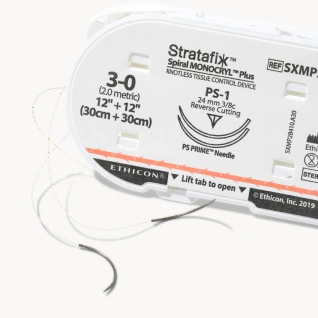Key Messages
- STRATAFIX™ Spiral PDS™ Plus Knotless Tissue Control Device can overcome the trade offs of other techniques with self-anchoring technology which provides multiple points of fixation along the suture line, combining the strength and security of interrupted closure, with the efficiency of continuous closure - with no knot-related complications such as increased risk of infection from bacterial attachment.1-5
- Incorporates antibacterial technology with triclosan coating, which has been shown to inhibit bacterial colonization of the suture for 11 days or more.8.Using STRATAFIX™ Symmetric PDS™ Plus sutures aligns with recommendations by the CDC, ACS/Surgical Infection Society, and NICE guidelines, which all advise that triclosan-coated sutures should be used to reduce the risk of SSIs.*†,9-13
- A meta-analysis of 21 randomized controlled trials showed a 28% reduction in SSI risk with the use of triclosan-coated sutures.2‡§
Detailed Talk Track
References
*Staphylococcus aureus, Staphylococcus epidermidis, Methicillin-resistant
†CDC, WHO, ACS/SIS, NICE, and KRINKO guidelines on reducing the risk of surgical site infections are general to triclosan-coated sutures and are not specific to any one brand.
‡All triclosan-coated sutures in these RCTs were Ethicon Plus Antibacterial Sutures (MONOCRYL™ Plus, VICRYL™ Plus, and PDS™ Plus).
§In a meta-analysis of 21 RCTs, 6462 patients, 95% CI: (14, 40%), P<0.001
1. Sissener T. Suture patterns. Comp Anim. 2006;11:14-19.
2. Boutros S, Weinfeld AB, Friedman JD. Continuous versus interrupted suturing of
traumatic lacerations: a time, cost, and complication rate comparison. J Trauma Injury
Infect Crit Care. 2000;48(3):495-497.
3. Seiler CM, Bruckner T, Diener MK, et al. Interrupted or continuous slowly absorbable
sutures for closure of primary elective midline abdominal incisions: a multicenter
randomized trial (INSECT: ISRCTN24023541). Ann Surg. 2009;249(3):576-582.
4. Moran ME, Marsh C, Perrotti M. Bidirectional-barbed sutured knotless running anastomosis v classic Van Velthoven suturing in a model system. J Endourol. 2007;21(10):1175-1178.
5. Vakil JJ, O’Reilly MP, Sutter EG, Mears SC, Belko SM, Khanuja HS. Knee arthrotomy repair with a continuous barbed suture: a biomechanical study. J Arthroplasty. 2011;26(5):710-713.
6. Bhende S, Burkley D, Nawrocki J. In vivo and in vitro antibacterial efficacy of absorbable barbed poydioxanone monofilament tissue control device with triclosan. Surg Infect 2018; Volume 19 (4):430-437.
7. Berríos-Torres SI, Umscheid CA, Bratzler DW, et al. Centers for Disease Control and Prevention Guideline for the Prevention of Surgical Site Infection. JAMA Surg. 2017;152(8):784_791.
doi:10.1001_jamasurg. 2017.0904.
8. World Health Organization. Global Guidelines for the Prevention of Surgical Site Infection. https:__apps.who.int_iris_bitstream_handle_10665_250680_9789241549882-eng.pdf?sequence=8. Published November 2016. Accessed August 24, 2023
9. Ban KA, Minei JP, Laronga C, et al. American College of Surgeons and Surgical Infection Society:
Surgical Site Infection Guidelines, 2016 Update. J Am Coll Surg. 2016;224(1):59_74.
10. National Institute for Health and Care Excellence (NICE) Guideline. Surgical site infections: prevention and treatment. NICE website. https:__www.nice.org.uk_guidance_ng125_chapter_Recommendations#closuremethods. Accessed August 24, 2023.
11. Prevention of postoperative wound infections. Recommendation of the Committee for Hospital Hygiene and Infection Prevention (KRINKO) at the Robert Koch Institute. Bundesgesundheitsbl. 2018; 61(4):448_473
12. de Jonge SW, Atema JJ, Solomkin JS, Boermeester MA. Meta-analysis and trial sequential analysis of triclosan-coated sutures for the prevention of surgical site infection. Brit J Surg. 2017;ePub-DOI: 10.1002_bjs.10445.
CONFIDENTIAL. FOR INTERNAL USE ONLY. NOT FOR USE WITH ANY CUSTOMER OR FOR EXTERNAL DISTRIBUTION.
